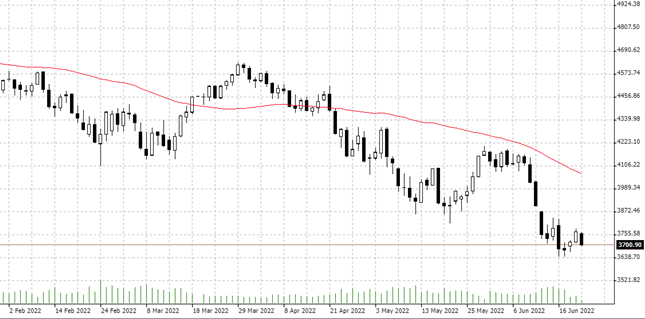

22.06.2022 – The bulls breathed a short sigh of relief: Recently, prices on Wall Street started to rise again. Just a bear market rally? Or a turnaround after all? For traders, it doesn’t matter. For investors, however, it does. For both, the arguments for and against the turnaround are interesting. We take a look behind the scenes.
Investors are already taking cover again. Yet the 50-day line in the S&P 500 continues to beckon. At some point, a return here should occur. So the bulls continue to lurk for the rebound. By the way, the previous week’s loss in the SPX was the highest since March 2020. If everyone has sold – who should still press the sell button?

Goldman Sachs, by the way, provided an explanation for last week’s sell-off. According to the Prime Brokerage department, hedge funds were selling off assets in a big way. And in a really big way: never before had so many dollars been turned over, the volume was higher than in the Lehman crash of 2008. Whereby it should be noted that Goldman’s data only goes back to April 2008. We think: This actually sets the stage for a strong countermovement.
Buying at the end of the month
So where do we go from here? JPMorgan’s strategy department now sees the possibility of a broader rally. Among other things, because of purchases at the end of the month, which could flush more than 100 billion dollars into the stock markets worldwide. We add: We also have quarter-end, which is when mutual funds deliver their reports. Fund managers would have some explaining to do if cash ratios are high. Ergo, they could get in now, especially after the setback.
Impending recession
And now the dissenting voice: Michael Wilson, chief investment officer at Morgan Stanley, sees the market as more fairly priced with the recent sell-off. However, the risk of a recession is still not priced in. And that means the S&P 500 could still very well dip as low as 3,000. In other words, the bear market will not be over until either the recession has arrived or the risk of an economic crisis is involved.
We hope that you make the right decisions in this mixed situation – Bernstein Bank stays on the ball for you!
Important Notes on This Publication:
The content of this publication is for general information purposes only. In this context, it is neither an individual investment recommendation or advice nor an offer to purchase or sell securities or other financial products. The content in question and all the information contained therein do not in any way replace individual investor- or investment-oriented advice. No reliable forecast or indication for the future is possible with respect to any presentation or information on the present or past performance of the relevant underlying assets. All information and data presented in this publication are based on reliable sources. However, Bernstein Bank does not guarantee that the information and data contained in this publication is up-to-date, correct and complete. Securities traded on the financial markets are subject to price fluctuations. A contract for difference (CFD) is also a financial instrument with leverage effect. Against this backdrop, CFD trading involves a high risk up to the point of total loss and may not be suitable for all investors. Therefore, make sure that you have fully understood all the correlating risks. If necessary, ask for independent advice. CFDs are complex instruments and are associated with the high risk of losing money quickly because of the leverage effect. 68% of retail investor accounts lose money trading CFD with this provider. You should consider whether you understand how CFD work and whether you can afford to take the high risk of losing your money.7
